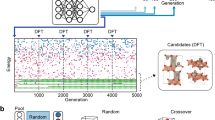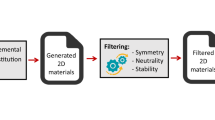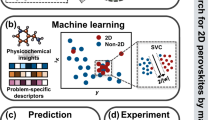Abstract
Inorganic–organic hybrid materials1,2,3 such as organically templated metal oxides1, metal–organic frameworks (MOFs)2 and organohalide perovskites4 have been studied for decades, and hydrothermal and (non-aqueous) solvothermal syntheses have produced thousands of new materials that collectively contain nearly all the metals in the periodic table5,6,7,8,9. Nevertheless, the formation of these compounds is not fully understood, and development of new compounds relies primarily on exploratory syntheses. Simulation- and data-driven approaches (promoted by efforts such as the Materials Genome Initiative10) provide an alternative to experimental trial-and-error. Three major strategies are: simulation-based predictions of physical properties (for example, charge mobility11, photovoltaic properties12, gas adsorption capacity13 or lithium-ion intercalation14) to identify promising target candidates for synthetic efforts11,15; determination of the structure–property relationship from large bodies of experimental data16,17, enabled by integration with high-throughput synthesis and measurement tools18; and clustering on the basis of similar crystallographic structure (for example, zeolite structure classification19,20 or gas adsorption properties21). Here we demonstrate an alternative approach that uses machine-learning algorithms trained on reaction data to predict reaction outcomes for the crystallization of templated vanadium selenites. We used information on ‘dark’ reactions—failed or unsuccessful hydrothermal syntheses—collected from archived laboratory notebooks from our laboratory, and added physicochemical property descriptions to the raw notebook information using cheminformatics techniques. We used the resulting data to train a machine-learning model to predict reaction success. When carrying out hydrothermal synthesis experiments using previously untested, commercially available organic building blocks, our machine-learning model outperformed traditional human strategies, and successfully predicted conditions for new organically templated inorganic product formation with a success rate of 89 per cent. Inverting the machine-learning model reveals new hypotheses regarding the conditions for successful product formation.
This is a preview of subscription content, access via your institution
Access options
Subscribe to this journal
Receive 51 print issues and online access
$199.00 per year
only $3.90 per issue
Buy this article
- Purchase on Springer Link
- Instant access to full article PDF
Prices may be subject to local taxes which are calculated during checkout




Similar content being viewed by others
References
Rao, C. N. R., Behera, J. N. & Dan, M. Organically-templated metal sulfates selenites and selenates. Chem. Soc. Rev. 35, 375–387 (2006)
Zhou, H.-C., Long, J. R. & Yaghi, O. M. Introduction to metal–organic frameworks. Chem. Rev. 112, 673–674 (2012)
Férey, G. Microporous solids: from organically templated inorganic skeletons to hybrid frameworks...ecumenism in chemistry. Chem. Mater. 13, 3084–3098 (2001)
Stranks, S. D. & Snaith, H. J. Metal-halide perovskites for photovoltaic and light-emitting devices. Nature Nanotechnol. 10, 391–402 (2015)
Cheetham, A. K., Férey, G. & Loiseau, T. Open-framework inorganic materials. Angew. Chem. Int. Ed. 38, 3268–3292 (1999)
Cundy, C. S. & Cox, P. A. The hydrothermal synthesis of zeolites: history and development from the earliest days to the present time. Chem. Rev. 103, 663–702 (2003)
Haushalter, R. C. & Mundi, L. A. Reduced molybdenum phosphates: octahedral-tetrahedral framework solids with tunnels, cages, and micropores. Chem. Mater. 4, 31–48 (1992)
Férey, G. Oxyfluorinated microporous compounds ULM-n: chemical parameters structures and a proposed mechanism for their molecular tectonics. J. Fluor. Chem. 72, 187–193 (1995)
Rao, C. N. R., Natarajan, S. & Neeraj, S. Exploration of a simple universal route to the myriad of open-framework metal phosphates. J. Am. Chem. Soc. 122, 2810–2817 (2000)
Holdren, J. P. et al. Material Genome Initiative Strategic Plan. Technical Report December 2014, https://www.whitehouse.gov/sites/default/files/microsites/ostp/NSTC/mgi_strategic_plan_-_dec_2014.pdf (National Science and Technology Council, 2014)
Sokolov, A. N. et al. From computational discovery to experimental characterization of a high hole mobility organic crystal. Nature Commun. 2, 437 (2011)
Hachmann, J. et al. Lead candidates for high-performance organic photovoltaics from high-throughput quantum chemistry – the Harvard Clean Energy Project. Energy Environ. Sci. 7, 698–704 (2014)
Colón, Y. J. & Snurr, R. Q. High-throughput computational screening of metal–organic frameworks. Chem. Soc. Rev. 43, 5735–5749 (2014)
Hautier, G., Fischer, C. C., Jain, A., Mueller, T. & Ceder, G. Finding nature’s missing ternary oxide compounds using machine learning and density functional theory. Chem. Mater. 22, 3762–3767 (2010)
Martin, R. L., Lin, L.-C., Jariwala, K., Smit, B. & Haranczyk, M. Mail-order metal–organic frameworks (MOFs): designing isoreticular MOF-5 analogues comprising commercially available organic molecules. J. Phys. Chem. C 117, 12159–12167 (2013)
Gaultois, M. W. et al. Data-driven review of thermoelectric materials: performance and resource considerations. Chem. Mater. 25, 2911–2920 (2013)
Kalidindi, S. R. & Graef, M. D. Materials data science: current status and future outlook. Annu. Rev. Mater. Res. 45, 171–193 (2015)
Zhao, J.-C. High-throughput experimental tools for the materials genome initiative. Chin. Sci. Bull. 59, 1652–1661 (2014)
Yang, S., Lach-hab, M., Vaisman, I. I. & Blaisten-Barojas, E. Identifying zeolite frameworks with a machine learning approach. J. Phys. Chem. C 113, 21721–21725 (2009)
Li, Y. & Yu, J. New stories of zeolite structures: their descriptions, determinations, predictions, and evaluations. Chem. Rev. 114, 7268–7316 (2014)
Fernandez, M., Boyd, P. G., Daff, T. D., Aghaji, M. Z. & Woo, T. K. Rapid and accurate machine learning recognition of high performing metal organic frameworks for CO2 capture. J. Phys. Chem. Lett. 5, 3056–3060 (2014)
Groom, C. R. & Reilly, A. M. Sixth blind test of organic crystal-structure prediction methods. Acta Crystallogr. B70, 776–777 (2014)
Thakur, T. S., Dubey, R. & Desiraju, G. R. Crystal structure and prediction. Annu. Rev. Phys. Chem. 66, 21–42 (2015)
Beran, G. J. O. A new era for ab initio molecular crystal lattice energy prediction. Angew. Chem. Int. Ed. 54, 396–398 (2015)
Wicker, J. G. P. & Cooper, R. I. Will it crystallise? Predicting crystallinity of molecular materials. CrystEngComm 17, 1927–1934 (2015)
Allen, F. H. The Cambridge Structural Database: a quarter of a million crystal structures and rising. Acta Crystallogr. B58, 380–388 (2002)
Olshansky, J. H. et al. Formation principles for vanadium selenites: the role of pH on product composition. Inorg. Chem. 53, 12027–12035 (2014)
JChem 6.1.3, http://www.chemaxon.com (ChemAxon, 2013)
Hastie, T., Tibshirani, R. & Friedman, J. The Elements of Statistical Learning 2nd edn, Ch. 9, 12, 13, 15 (Springer, 2009)
Cortes, C. & Vapnik, V. Support-vector networks. Mach. Learn. 20, 273–297 (1995)
Üstün, B., Melssen, W. & Buydens, L. M. C. Facilitating the application of support vector regression by using a universal Pearson VII function based kernel. Chemom. Intell. Lab. Syst. 81, 29–40 (2006)
Hall, M. et al. The WEKA data mining software: an update. ACM SIGKDD Explor. Newslett. 11, 10–18 (2009)
Chang, C.-C. & Lin, C.-J. LIBSVM: a library for support vector machines. ACM Trans. Intell. Syst. Technol. 2, 27 (2011)
Joachims, T. Text categorization with support vector machines: Learning with many relevant features. In Proc. 10th European Conf. Machine Learning (eds Nédellec, C. & Rouveirol, C. ) 137–142 (Springer, 1998)
Leach, A. & Gillet, V. J. An Introduction to Chemoinformatics Ch. 5 (Springer, 2007)
Riniker, S. & Landrum, G. A. Open-source platform to benchmark fingerprints for ligand-based virtual screening. J. Cheminformat. 5, 26 (2013)
Thangavelu, S. G., Butcher, R. J. & Cahill, C. L. Role of N-donor sterics on the coordination environment and dimensionality of uranyl thiophenedicarboxylate coordination polymers. Cryst. Growth Des. 15, 3481–3492 (2015)
R Core Team. R: A Language and Environment for Statistical Computing http://www.R-project.org/ (R Foundation for Statistical Computing, 2015)
Barakat, N. & Diederich, J. Eclectic rule-extraction from support vector machines. Int. J. Comput. Intell. 2, 59–62 (2005)
Acknowledgements
We thank Y. Huang, G. Martin-Noble and D. Reilley for data entry and J. H. Koffer for synthetic efforts. M.Z. acknowledges support for the purchase of a diffractometer by the National Science Foundation (DMR 1337296), the Ohio Board of Reagents grant CAP-491 and from Youngstown State University. This work was supported by the National Science Foundation (DMR-1307801). A.J.N. and J.S. each acknowledge the Henry Dreyfus Teacher-Scholar Award program.
Author information
Authors and Affiliations
Contributions
S.A.F., J.S. and A.J.N. conceived the project and wrote the paper. A.J.N. supervised the data capture. C.F. developed the web-accessible database. A.J.N. and P.D.F.A. tested the data reliability. J.S. and P.R. developed the reactant descriptors. P.R., C.F. and S.A.F. developed the machine-learning models. J.S. performed diamine selection. P.D.F.A performed the Cambridge Structural Database search. K.C.E., M.B.W. and A.M. performed the hydrothermal experimental reactions, supervised by A.J.N. M.Z. performed X-ray crystallography on the resulting products. P.D.F.A. performed the statistical analyses. P.D.F.A., A.J.N., J.S. and S.A.F. performed the decision-tree calculation and analysis. All authors discussed the results and commented on the manuscript.
Corresponding authors
Ethics declarations
Competing interests
The authors declare no competing financial interests.
Supplementary information
Supplementary Information
This file contains Supplementary Text and Data, Supplementary Tables 1-10 and Supplementary Figures 1-5. Included are tables of descriptor definitions, model evaluation results, a learning curve, synthetic and crystallographic details, packing figures, amine structures and a full decision tree. (PDF 1975 kb)
Supplementary Data
This file contains information on the historical reactions, gathered from historical laboratory notebooks. This was the data used to construct the SVM model described in the manuscript. (CSV 5260 kb)
Supplementary Data
This file contains information on the new experiments that were performed to test whether the model improved upon human strategies ("chemical intuition”), during the course of this study. These reactions were not used to train the model. (CSV 369 kb)
Supplementary Data
This shell script file contains the specific model names and parameters used in the model construction described in Table S5 of the Supplementary Information. (TXT 1 kb)
Supplementary Data
This file contains the full crystallographic details for [C6H22N4][VO(C2O4)(SeO3)]2·2H2O. (CIF 19 kb)
Rights and permissions
About this article
Cite this article
Raccuglia, P., Elbert, K., Adler, P. et al. Machine-learning-assisted materials discovery using failed experiments. Nature 533, 73–76 (2016). https://doi.org/10.1038/nature17439
Received:
Accepted:
Published:
Issue Date:
DOI: https://doi.org/10.1038/nature17439
This article is cited by
-
Enabling late-stage drug diversification by high-throughput experimentation with geometric deep learning
Nature Chemistry (2024)
-
Transfer learning for inverse design of tunable graphene-based meta-surfaces
Journal of Materials Science (2024)
-
Accelerated discovery of high-performance 3D printing materials using multi-objective active optimization method
Journal of Materials Science (2024)
-
Comparative study of crystal structure prediction approaches based on a graph network and an optimization algorithm
Science China Materials (2024)
-
Uncovering the generic and alloy-specific governing parameters of deformation-induced martensitic transformation in austenitic steel
Journal of Materials Science (2024)
Comments
By submitting a comment you agree to abide by our Terms and Community Guidelines. If you find something abusive or that does not comply with our terms or guidelines please flag it as inappropriate.



